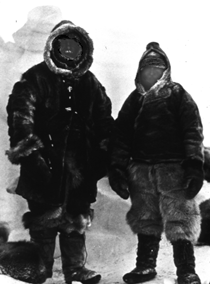


Alfred Lothar Wegener (1880-1930), the originator of the theory of continental drift. (Photograph courtesy of the Alfred Wegener Institute for Polar and Marine Research, Bremerhaven, Germany.)
Wegener obtained his doctorate in planetary astronomy in 1905 but soon became interested in meteorology; during his lifetime, he participated in several meteorologic expeditions to Greenland. Tenacious by nature, Wegener spent much of his adult life vigorously defending his theory of continental drift, which was severely attacked from the start and never gained acceptance in his lifetime. Despite overwhelming criticism from most leading geologists, who regarded him as a mere meteorologist and outsider meddling in their field, Wegener did not back down but worked even harder to strengthen his theory.
A couple of years before his death, Wegener finally achieved one of his lifetime goals: an academic position. After a long but unsuccessful search for a university position in his native Germany, he accepted a professorship at the University of Graz in Austria. Wegener's frustration and long delay in gaining a university post perhaps stemmed from his broad scientific interests. As noted by Johannes Georgi, Wegener's longtime friend and colleague, "One heard time and again that he had been turned down for a certain chair because he was interested also, and perhaps to a greater degree, in matters that lay outside its terms of reference -- as if such a man would not have been worthy of any chair in the wide realm of world science."
Ironically, shortly after achieving his academic goal, Wegener died on a meteorologic expedition to Greenland. Georgi had asked Wegener to coordinate an expedition to establish a winter weather station to study the jet stream (storm track) in the upper atmosphere. Wegener reluctantly agreed. After many delays due to severe weather, Wegener and 14 others set out for the winter station in September of 1930 with 15 sledges and 4,000 pounds of supplies. The extreme cold turned back all but one of the 13 Greenlanders, but Wegener was determined to push on to the station, where he knew the supplies were desperately needed by Georgi and the other researchers. Travelling under frigid conditions, with temperatures as low as minus 54 °C, Wegener reached the station five weeks later. Wanting to return home as soon as possible, he insisted upon starting back to the base camp the very next morning. But he never made it; his body was found the next summer.

Alfred Wegener (left) and an Innuit guide on 1 November 1930 during his final meteorological expedition in Greenland. This is one of the last photographs of Wegener, who died later during the expedition (see text). (Photograph courtesy of the Alfred Wegener Institute for Polar and Marine Research, Bremerhaven, Germany.)
Wegener was still an energetic, brilliant researcher when he died at the age of 50. A year before his untimely death, the fourth revised edition (1929) of his classic book was published; in this edition, he had already made the significant observation that shallower oceans were geologically younger. Had he not died in 1930, Wegener doubtless would have pounced upon the new Atlantic bathymetric data just acquired by the German research vessel Meteor in the late 1920s. These data showed the existence of a central valley along much of the crest of the Mid-Atlantic Ridge. Given his fertile mind, Wegener just possibly might have recognized the shallow Mid-Atlantic Ridge as a geologically young feature resulting from thermal expansion, and the central valley as a rift valley resulting from stretching of the oceanic crust. From stretched, young crust in the middle of the ocean to seafloor spreading and plate tectonics would have been short mental leaps for a big thinker like Wegener. This conjectural scenario by Dr. Peter R. Vogt (U.S. Naval Research Laboratory, Washington, D.C.), an acknowledged expert on plate tectonics, implies that "Wegener probably would have been part of the plate-tectonics revolution, if not the actual instigator, had he lived longer." In any case, many of Wegener's ideas clearly served as the catalyst and framework for the development of the theory of plate tectonics three decades later.